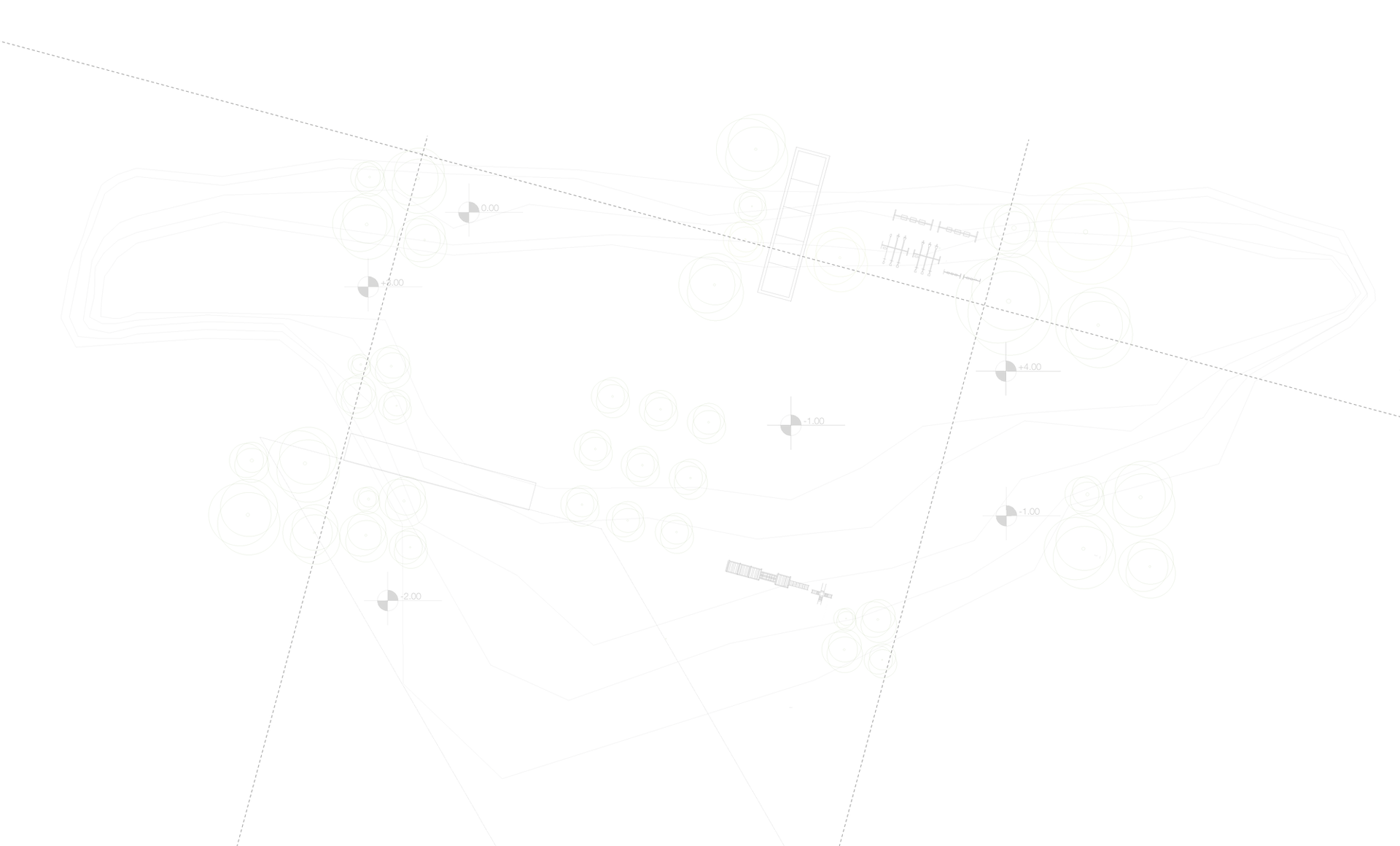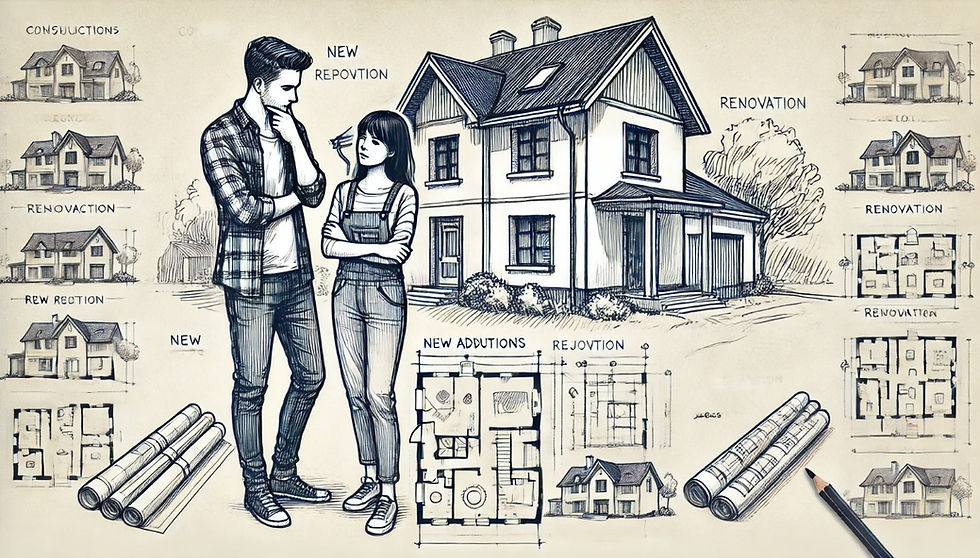The Creative Dialogue: An Immersion into the Architectural Design Process
- Justine Gratton
- Mar 21
- 6 min read
An architectural project in mind, but how do you bring it to life? How do you turn ideas, sometimes intuitive, into a unique, adapted and timeless space?
The design phase is much more than a simple technical step. It embodies a dialogue where personal aspirations and professional expertise meet to lay the foundations of a unique and thoughtful project. Every detail counts: listening, analyzing, understanding. This is where a shared vision is born, enriched by a deep understanding of needs and constraints. This alchemy of ideas becomes an opportunity to create spaces that exceed expectations, carrying meaning and identity.
Are you looking to start a renovation or construction project with an architect?
This article will guide you through:
Discover the key steps needed to start an architectural project, from the first meeting to the creation of sketches.
Understand how a thorough analysis of needs, constraints, and budget ensures the success of a project.
Explore the collaborative role between the client and the architect to transform your ideas into a clear and achievable concept.
Understand the importance of the conceptual phase and visualization tools to bring your vision to life.
Whether you are new to or familiar with the architectural process, this article will guide you through the essential steps to begin your project with confidence.
Pre-concept: Building the Foundations of a Vision
Each decision in the early stages of a project has a disproportionate impact on the final success. In the pre-concept phase, ideas are still fluid, changes are inexpensive, and adjustments are easy to integrate.

As the project progresses, the resources consumed increase, making changes more complex and costly. This is why collaborating with an architect from this phase allows you to optimize each decision, while laying solid foundations for the following steps.
Key steps in the design process
The architectural journey is based on a methodical progression, guaranteeing a fluid transition between reflection, design and execution.
Pre-design phase: laying the foundations
1. Objectives and budget
Identify functional, aesthetic and financial priorities.
2. Regulatory study
Study site constraints, such as zoning or regulations.
3. Surveys + data collection
Precisely map the existing situation or analyze the characteristics of a blank site.
Conceptual phase: explore and refine
1. Needs analysis
Identify and understand user expectations and project constraints in order to lay clear and appropriate foundations.
It includes:
Spatial analysis:
Understanding volumes, analysis of dimensions, traffic flows and current use of spaces in relation to the client's expectations.
Assessment of constraints and opportunities:
Structural aspects, positioning on the site, regulatory and technical conditions influencing development choices.
Exploration of development scenarios:
Identification of solutions adapted to the functional and aesthetic requirements of the project.

2. Volumetric study + organization of spaces:
The study of the relationships between spaces allows to analyze the spatiality, the circulations and the new relationships between the spaces using plans and conceptual volumetric models in order to create development options in harmony with your expectations. During expansion work or new constructions, this phase allows to evaluate the relationship between the current volumes and the possibilities of transformation while taking into account your specific needs.

3. Interior design options
Exploration of various spatial configurations to optimize comfort, functionality and aesthetics in accordance with client expectations.

4. Facade options
Proposal of creative solutions to define the exterior architectural identity, harmoniously integrating the project into its environment while respecting technical and aesthetic constraints.


5. Immersive visualization - interior & exterior
Finally, the last conceptual stage offers realistic immersion through detailed texture-free renderings, allowing the client to fully visualize the layout of the spaces and the integration of the project in its context.

Preliminary phase: taking action
Once the sketches have been refined and approved, this stage marks the finalization of the design choices and the move to the realization of the preliminary plans with a view to applying for a permit.
Here is a summary of the different stages of creating a project:

Ideas with tangible dimensions: a meeting between vision and expertise
Transforming ideas into a concrete project is a collaborative process, where your vision and the architect’s expertise enrich each other.
Your role: Your aspirations, priorities and perception of spaces are at the heart of the project. Whether it is a need for functionality, a desire for aesthetics or a desire to reflect your identity, these elements guide the first stages of the design.
Your responsibilities within the project:
1. Définir les besoins et objectifs du projet
Exprimer vos attentes : Décrire clairement vos besoins, préférences, et contraintes (ex. budget, délais, style architectural, fonctionnalités).
Clarifier les priorités : Identifier les éléments essentiels (par ex., durabilité, esthétique, confort) pour guider l’architecte dans ses choix
2. Fournir des informations précises
Partager les documents nécessaires : Fournir des titres de propriété, des relevés cadastraux, ou toute information technique pertinente.
Donner accès au site : Faciliter les visites sur site pour que l’architecte puisse évaluer les conditions existantes.
3. Établir un budget réaliste
Communiquer un budget clair : Indiquer une enveloppe budgétaire dès le départ pour que l’architecte puisse concevoir en conséquence.
Prévoir une marge : Prévoir une réserve pour les imprévus, particulièrement lors de rénovations.
4. Participer activement à la conception
Donner des retours : Examiner les esquisses, plans et propositions, et fournir des commentaires constructifs rapidement.
Valider les étapes : Approuver les phases importantes du projet avant de passer à l’étape suivante.
Maintenir une communication ouverte : Informer l’architecte de tout changement dans leurs besoins ou contraintes dès que possible.
L’apport de l’architecte : Grâce à une analyse technique et une créativité maîtrisée, l’architecte traduit ces idées en solutions concrètes. Il ajuste les attentes aux contraintes du site, tout en proposant des perspectives nouvelles pour enrichir la vision initiale.
Principales responsabilités de l'architecte au sein du projet avec vous
Vérifier la faisabilité de votre projet, en tenant compte des contraintes techniques, budgétaires et environnementales.
Étudier les codes et réglementations spécifiques à votre projet, incluant les normes de construction, de sécurité et d’urbanisme.
Comprendre vos attentes et les respecter tout au long du processus de conception et de réalisation.
Vous tenir informé à chaque étape, afin que vous puissiez suivre l'évolution du projet en toute transparence.
Vous guider dans vos choix, en agissant à titre de conseiller pour vous aider à prendre des décisions éclairées.
Élaborer des concepts de design en accord avec vos exigences et les contraintes du site.
Produire les plans et documents techniques, incluant les esquisses, les plans détaillés et les spécifications techniques.
Coordonner les différents intervenants, tels que les ingénieurs, les entrepreneurs et les autorités locales, pour assurer la fluidité du projet.
Superviser le chantier, afin de garantir que les travaux sont réalisés conformément aux plans et aux normes.
Gérer les imprévus, en apportant des solutions efficaces aux problèmes qui pourraient survenir.
Intégrer des solutions durables, en tenant compte des aspects écologiques et écoénergétiques adaptés à vos besoins.
Assurer le contrôle de la qualité et de la conformité, pour vous offrir un résultat à la hauteur de vos attentes.
Ce dialogue entre le client et l’architecte permet de donner naissance à des espaces qui allient pragmatisme et sensibilité, équilibre et originalité. Chaque ligne tracée, chaque volume conçu devient le reflet de cette collaboration unique.

Harmonisation des visions

Un projet réussi est avant tout le fruit d’une collaboration authentique. Il s’agit de faire converger deux visions : celle de l’usager, ancrée dans ses besoins et aspirations, et celle de l’architecte, guidée par son expertise technique et créative. Cette rencontre donne naissance à une conception sur mesure, où chaque espace reflète à la fois l’identité de ses occupants et les contraintes du site.

Le chemin de la conception n’est pas toujours linéaire. Ce qui commence comme une idée peut évoluer face aux contraintes techniques ou budgétaires. L’architecte joue ici un rôle clé, en ajustant les attentes pour garantir un équilibre entre vision initiale et faisabilité.
Conclusion : créer des espaces qui inspirent
Chaque projet architectural commence par un dialogue, où la créativité rencontre la rigueur. Ce processus collaboratif, ancré dans une méthodologie structurée et enrichi par des outils modernes, garantit des réalisations qui dépassent leurs simples fonctions.

L’architecture est bien plus qu’une réponse à des contraintes : c’est une invitation à réinventer les espaces pour qu’ils racontent une histoire unique, celle de leurs occupants.
Nous sommes là pour transformer vos idées en réalité. Contactez-nous dès aujourd’hui pour entamer ensemble cette aventure et donner vie à votre projet.




